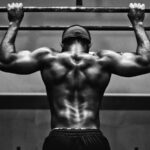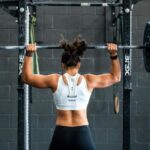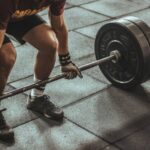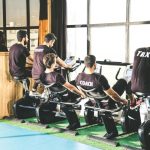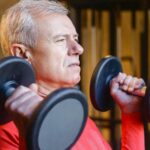Strength training at home has become an increasingly popular fitness strategy for individuals looking to build muscle, improve strength, and enhance overall health without the need for a gym or equipment. By leveraging one’s own body weight, these workouts can effectively target multiple muscle groups, providing a comprehensive training session that rivals traditional gym-based routines. These at-home workouts are not only convenient for those with busy schedules or limited access to a gym but also economical, as they eliminate the need for expensive gym memberships and fitness equipment.
The versatility of bodyweight exercises allows for a wide array of strength training routines that can be customized to suit different fitness levels and goals. From push-ups and planks to squats and lunges, these exercises can be modified to increase or decrease intensity, making them suitable for both beginners and experienced fitness enthusiasts alike. The adaptability of at-home workouts ensures that users can continue to challenge their bodies as they progress, leading to continual improvement in strength and endurance.
In addition to the accessibility and flexibility of no-equipment strength training, home workouts also offer privacy and the comfort of familiar surroundings, potentially boosting adherence to a fitness regimen. They emphasize the importance of consistency and proper technique, which can lead to significant gains in strength over time. By incorporating a variety of bodyweight exercises and focusing on form, individuals can achieve a full-body workout that not only improves muscle tone but also contributes to better posture, increased metabolism, and overall well-being.
The Fundamentals of Strength Training Without Equipment
Strength training without equipment primarily involves leveraging one’s own body weight to create resistance, which can lead to increases in muscle mass and overall fitness. Through a variety of bodyweight exercises, individuals can construct an effective fitness routine that builds muscle and enhances strength.
Understanding Bodyweight Exercises
Bodyweight exercises are movements that use the individual’s own weight to provide resistance against gravity. These exercises are versatile and can be modified to suit any fitness level, from beginners to advanced practitioners. A well-rounded bodyweight fitness routine should include a mix of:
- Push exercises: such as push-ups and tricep dips.
- Pull exercises: including pull-ups and inverted rows. (Note: pull-ups may require a bar or stable overhead structure to perform.)
- Leg exercises: like squats, lunges, and pistol squats.
- Core exercises: consisting of planks, sit-ups, and leg raises.
Incorporating these types of movements ensures that all major muscle groups are engaged, supporting balanced development and reducing the risk of injury.
Benefits of Home Workouts
Home workouts that require no equipment offer multiple benefits. Here are a few key advantages:
- Convenience: They can be performed anywhere, at any time, without the need for travel to a gym.
- Cost-effective: Eliminating the need for gym memberships or expensive equipment makes it an affordable option.
- Flexibility: Individuals can tailor their workout to their own schedule and fitness level, adjusting the intensity and volume as needed.
Moreover, bodyweight training promotes improved body awareness, balance, and coordination. It aids in developing relative strength—the strength to handle one’s own body—which is functional and applicable to everyday activities.
Designing Your No-Equipment Workout Routine
An effective no-equipment workout routine balances variety, intensity, and recovery. One should design it to include exercises that cover all major muscle groups and consider their fitness levels and goals.
Creating a Balanced Exercise Plan
In a balanced exercise plan, one should aim to incorporate movements targeting the upper body, lower body, core, and cardiovascular system. A sample plan could include push-ups and planks for the upper body and core, squats and lunges for the lower body, and burpees for an added cardiovascular challenge. Here’s a structure for a circuit training session that combines these elements:
- Circuit 1:
- 10-15 push-ups
- 15-20 squats
- 30-second plank
- 10 burpees
Repeat the circuit 2-3 times with a brief rest between each exercise.
- Circuit 2:
- 10-12 lunges (each leg)
- 15-20 sit-ups
- 30-second side plank (each side)
- 15 jumping jacks
Perform this circuit 2-3 times with a minute of rest between circuits to allow for recovery. Each exercise within the circuits should be executed with control and proper form to maximize effectiveness and minimize the risk of injury.
Setting Personal Fitness Goals
A person’s fitness goals directly influence the structure of their workout routine. Suppose one’s goal is to build strength; they should focus on increasing the intensity of exercises by incorporating more repetitions, adding isometric holds, or reducing rest periods. If improving cardiovascular health is the aim, one should include exercises that elevate the heart rate and can be done in quick succession to maintain a high-intensity level. One might track progress with a simple logbook or mobile app to adjust the routine as fitness improves, ensuring continuous challenge and growth.
Core and Stability Training at Home
Strengthening the core and improving stability is essential for overall fitness. Focused, equipment-free exercises can be performed right at home to enhance core strength and spine stability, providing a foundation for better balance and daily function.
Mastering the Plank Variations
The traditional plank is a cornerstone exercise for core strengthening. It involves maintaining a push-up position while resting on the forearms. The individual should aim to keep their body in a straight line from head to heels and actively engage the core and glutes to support the spine. Progressions include:
- Side Plank: By aligning one elbow under the shoulder and stacking the feet, this variation works the obliques and improves lateral stability.
- Extended Plank: By placing the hands further in front of the head, the extended plank increases the difficulty and further challenges the core.
One can increase the intensity by integrating movements such as leg lifts or by extending an arm forward.
Incorporating Balance Exercises
Balance exercises complement core workouts by challenging the body’s stability and engaging multiple muscle groups. Examples include:
- Single-leg Stance: The simple act of standing on one foot forces the core to stabilize the entire body. Over time, one can close their eyes or stand on a cushion to further challenge their balance.
- Leg Swings: Holding onto a sturdy object for support, one can perform leg swings forward and back, then side to side, all while keeping the core engaged and maintaining an upright posture.
These balance exercises are not only beneficial for core strength but also enhance coordination and proprioception, contributing to overall stability and injury prevention.
Lower Body Workouts for Strength and Endurance
Lower body workouts are essential for building strength and endurance in the legs and glutes. They can be performed at home without any equipment, relying on body weight to provide resistance. These exercises target various muscle groups including the glutes, hamstrings, and calves, and are effective in enhancing muscular definition and overall lower body health.
Squat and Lunge Variations
Squats are a staple in lower body workouts due to their effectiveness in working the quads, hamstrings, and glutes. A basic bodyweight squat is performed by standing with feet hip-width apart, lowering into a squat position, and then rising back to standing. For those seeking a challenge, the single-leg squat intensifies the exercise by focusing on one leg at a time.
Lunges, on the other hand, are versatile and target the same muscle groups with a focus on balance and coordination. The classic forward lunge involves taking a step forward into a lunge, keeping the back straight and lowering the hips until both knees are bent at about a 90-degree angle. To increase difficulty or target different muscles, one can perform side lunges which also engage the inner and outer thighs.
Exercises for Legs and Glutes
For specifically targeting the glutes, exercises like hip thrusts and bridges are highly effective. A hip thrust is performed by lying on the back with knees bent and feet flat on the floor, then lifting the hips towards the ceiling while squeezing the glutes. Bridges follow a similar pattern but can be intensified by elevating the feet or adding single-leg variations.
To work the legs comprehensively, calf raises are simple yet powerful. They involve standing on the balls of the feet and pushing up to a tiptoe position, then lowering down. This exercise strengthens the calves and can be done anywhere with a raised surface for an extended range of motion. For the hamstrings, exercises like the single-leg deadlift can be performed using bodyweight alone. This involves standing on one leg, hinging forward at the hips while maintaining a straight back, and then returning to the starting position.
Incorporating these exercises into a routine can help individuals build strength and endurance in their lower body without the need for equipment.
Upper Body Exercises Without Weights
Building upper body strength doesn’t necessarily require weights or gym equipment. One can engage in a variety of exercises that use body weight as resistance to work on the chest, arms, and shoulder muscles effectively.
Push-Up Techniques for Chest and Shoulders
- Standard Push-Up: Begin in a high plank position, with hands placed shoulder-width apart and back straight. Lower the body until the chest almost touches the ground, then push back up. This move targets the chest and shoulders.
- Incline Push-Up: By elevating the hands on a stable surface like a bench or step, the incline push-up targets the lower chest and shoulder muscles differently.
- Decline Push-Up: Similar to the incline but with feet elevated, the decline push-up shifts the focus to the upper chest and front shoulders.
Arm and Back Strengthening Moves
- Tricep Dips: Sit on the edge of a chair or bench, placing hands beside the hips. Move forward off the bench, bending the elbows to lower the body, then push back up to engage the triceps.
- Arm Circles: Standing with arms extended laterally, perform small circles for 30 seconds to a minute. This simple exercise activates the shoulders without any equipment.
- Walk-Outs: From a standing position, hinge at the hips to touch the ground, then walk hands forward to enter a high plank. This exercise strengthens the arms and back muscles as one transitions in and out of the plank position.
Each exercise can be performed in sets or integrated into a circuit, with consistent practice leading to improved muscle tone and endurance in the upper body without the need for weights.
Incorporating High-Intensity Cardio into Strength Training
Integrating high-intensity cardio into strength training enhances fat burning and muscle building. One can perform this hybrid training effectively at home with no equipment.
Cardio Workouts for Fat Loss
Cardio exercises such as burpees and jumping jacks are potent tools for fat loss. They elevate the heart rate quickly, increasing calorie burn.
- Burpees: A full-body exercise that promotes cardiovascular endurance and strength. One should aim for quick succession to maintain high-intensity levels.
- Sequence: Start in standing position, drop into a squat with hands on the ground, kick back into a plank, perform a push-up, return to squat, and then jump up.
- Duration: 20-30 seconds per set, tailored to individual fitness levels.
- Jumping Jacks: These target several muscle groups and aid in improving aerobic conditioning.
- Sequence: Stand upright, jump to a position with legs spread wide and hands touching overhead, then return to the initial position.
- Duration: Aim for time intervals such as 45-60 seconds.
Blending Strength and Cardio Exercises
Creating a hybrid workout at home involves alternating between strength movements and cardio bursts.
- Circuit Format: Alternate strength exercises like squats or lunges with cardio moves.
- Example Circuit:
- Strength: Squats – 45 seconds
- Cardio: Jumping Jacks – 30 seconds
- Repeat: Aim for three full circuits to optimize the workout.
- Example Circuit:
- Intensity: Adjustment of intensity and rest periods are crucial to cater to one’s fitness level.
- Beginners: Start with longer rest between sets.
- Advanced: Shorten rest periods to maintain high heartbeat and intensify the workout.
Flexibility and Recovery After Home Workouts
After a thorough home workout, it is crucial for an individual to focus on flexibility and recovery processes to enhance their range of motion and decrease the likelihood of injuries.
The Importance of Stretching
Stretching is an essential part of fitness that improves flexibility and increases the muscles’ range of motion. Post-workout stretching can help in mitigating muscle tightness and preparing the muscles for the next session. Simple dynamic stretches such as arm swings, leg kicks, and torso twists are effective for maintaining flexibility. On the other hand, static stretches like hamstring stretches, quadriceps stretches, and calf stretches are best performed after workouts to deepen the stretch as the body is already warm.
Cooling Down and Reducing Injury Risk
Cooling down after a workout is just as important as the initial warm-up. It involves performing activities at a slower pace and reduced intensity. Cooling down helps to gradually decrease heart rate and can be helpful in reducing the risk of injuries. Gentle walking or light jogging can serve as cooling-down methods. Moreover, incorporating breathing exercises can aid in the recovery process by helping to oxygenate the muscles. An effective cooling down routine also assists in clearing lactic acid buildup, which can contribute to muscle stiffness and discomfort.
Advancing Your Home Strength Training Practice
To effectively enhance home-based strength training, one must explore strategies such as progressive overload without equipment and integrating comprehensive full-body workouts. These methods cater to the continuous improvement of strength and muscle endurance without the need for specialized gym equipment.
Progressive Overload Without Equipment
Progressive overload is the gradual increase of stress placed upon the body during exercise training. In the absence of equipment, individuals can still apply this principle to their strength training routine in the following ways:
- Increase Repetitions: For a given exercise, they can aim to increase the number of repetitions over time.
- Slower Rep Tempo: Slowing down the tempo of each repetition adds tension and can create greater muscle fatigue.
- Shorten Rest Intervals: By reducing the rest time between sets, they can increase the intensity and endurance demand on the muscles.
- Alter Lever Length: Changing the position of the limbs during an exercise can make the bodyweight feel heavier. For example, extending legs further away from the body during planks.
- One-Limb Variation: Switching from a two-limb exercise to a single-limb version, like doing a one-arm pushup, adds significant challenge.
Challenging Full-Body Workouts
Full-body workouts recruit multiple muscle groups, offering a comprehensive approach to resistance training. They can be structured to encompass various functional movements that enhance overall strength. Examples include:
- Squats: Targeting the lower body, squats can be varied in depth and speed.
- Push-Ups: A classic upper-body exercise that can be modified to increase difficulty, such as elevating the feet.
- Planks: Core strength can be developed with different plank variations, focusing on stability and core engagement.
- Burpees: This full-body exercise combines a squat, push-up, and jump to challenge cardiovascular endurance and muscle strength.
By incorporating these exercises and strategies, individuals can ensure that their home strength training remains challenging and effective, promoting continual physical development.

